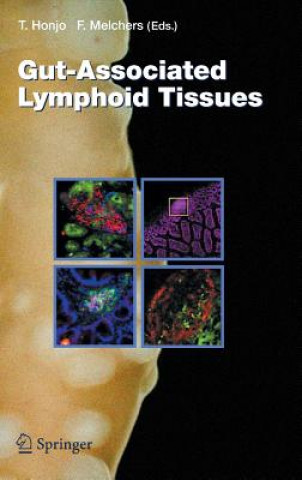
Code: 01561464
Gut-Associated Lymphoid Tissues
by Tasuku Honjo, Fritz Melchers
The intestine is the front line of the confrontation between pathogens and the immune system. However, it is also important to emphasize that we have a symbiotic relationship with innumerable bacteria in the intestine. In the gast ... more
- Language:
 English
English - Binding: Hardback
- Number of pages: 210
Publisher: Springer-Verlag Berlin and Heidelberg GmbH & Co. KG, 2006
- More about this

189.71 €

Low in stock at our supplier
Shipping in 10 - 15 days
Potřebujete více kusů?Máte-li zájem o více kusů, prověřte, prosím, nejprve dostupnost titulu na naši zákaznické podpoře.
Add to wishlist
You might also like
-

Knitters Handy Book Of Patterns
20.94 € -20 % -

Impact of the Social Sciences
94.80 € -9 % -

No Humans Involved
10.47 € -28 % -

Astadala Yogamala Vol.3 the Collected Works of B.K.S Iyengar
27.72 € -19 % -

Jungenforschung empirisch
47.75 € -4 % -

Aus meiner Kinder- und Jugendzeit auf Hiddensee 1944 - 1957
14.58 € -1 % -

Beton Und Seine Anwendung
68.50 €
Give this book as a present today
- Order book and choose Gift Order.
- We will send you book gift voucher at once. You can give it out to anyone.
- Book will be send to donee, nothing more to care about.
More about Gut-Associated Lymphoid Tissues
You get 467 loyalty points
 Book synopsis
Book synopsis
The intestine is the front line of the confrontation between pathogens and the immune system. However, it is also important to emphasize that we have a symbiotic relationship with innumerable bacteria in the intestine. In the gastrointestinal tract of mammals the lower intestine harbors around 1,000 12 species of anaerobic and aerobic bacteria, in densities up to 10 /mlinthe distal small intestine, the cecum, and the colon. A single layer of epithelial cells of the intestine protects the internal organs of the mammalian host from these bacteria. Below these epithelial cells the gut-associated lymphoid tissues (GALT), organized in Peyer s patches, cryptopatches, and isolated l- phoid follicles, as well as isolated, dispersed single cells in the epithelial layer (intraepithelial lymphocytes) and lamina propria, are composed of T l- phocytes, B lymphocytes, Ig-secreting plasma cells, and antigen-presenting cells such as dendritic cells. The importance of the gut barrier is striking, if we consider that in humans the epithelial surface, behind which the immune system faces and senses the endogenous bacteria, is estimated to be as large as a basketball court. Perhaps not surprising then, the gut contains appr- imately half of all lymphocytes of our immune system. Colonization of the intestine with the ?ora of commensal bacteria induces the development of the GALT, which in turn responds by the development of IgA-secreting plasma cells. Dimeric and multimeric IgAs can traverse the epithelial layer and are released in the gut lumen, where they bind bacteria.
 Book details
Book details
Book category Books in English Medicine Clinical & internal medicine Diseases & disorders
189.71 €
- Full title: Gut-Associated Lymphoid Tissues
- Author: Tasuku Honjo, Fritz Melchers
- Language:
 English
English - Binding: Hardback
- Number of pages: 210
- EAN: 9783540306566
- ISBN: 3540306560
- ID: 01561464
- Publisher: Springer-Verlag Berlin and Heidelberg GmbH & Co. KG
- Weight: 1090 g
- Dimensions: 235 × 155 × 13 mm
- Date of publishing: 10. July 2006
Trending among others
-

Healing Add
17.86 € -17 % -

Bethesda Handbook of Clinical Oncology
70.97 € -4 % -

Autoimmune Solution
11.49 € -28 % -

Emperor of All Maladies
12.52 € -22 % -

Healing Lyme Disease Coinfections
17.25 € -19 % -

Natural Treatments for Lyme Coinfections
16.94 € -20 % -

TNM Classification of Malignant Tumours 8e
52.17 € -3 % -

Complete Guide to Breast Cancer
17.55 € -28 % -

Genetics and Epigenetics of Breast Cancer
178.62 € -

Gout & Its Cure
5.02 € -18 % -

Radical Remission
18.07 € -12 % -

Infectious Diseases: A Clinical Short Course
111.85 € -

Cancer as a Metabolic Disease - On the Origin, Management, and Prevention of Cancer
163.52 € -

Comprehensive Review of Infectious Diseases
144.21 € -4 % -

How to Starve Cancer
19.40 € -29 % -

Cancer Is Not a Disease - It's a Healing Mechanism
28.24 € -2 % -

Roitt's Essential Immunology 13e
64.39 € -1 % -

CT Anatomy for Radiotherapy
92.33 € -

Breast Ultrasound
97.57 € -4 % -

Spillover
15.19 € -

Lanzkowsky's Manual of Pediatric Hematology and Oncology
223.20 € -

Principles of Gynecologic Oncology Surgery
339.58 € -

Musculoskeletal Imaging
90.18 € -

Radiation Oncology Management Decisions
112.26 € -10 % -

Emergency Management of Infectious Diseases
128.90 € -15 % -

Atlas of Contrast-enhanced Sonography of Focal Liver Lesions
108.36 € -4 % -

Color Atlas of Immunology
23.51 € -4 % -

Key to Self-Liberation
89.46 € -

Handbook of Breast MRI
125.41 € -1 % -

Stereotactic Radiosurgery and Stereotactic Body Radiation Therapy (SBRT)
295.10 € -

Palliative Radiation Oncology
198.85 € -9 % -

Health and Disease Begin in the Colon
47.65 € -

Abeloff's Clinical Oncology
423.20 € -

Illustrated Anatomical Segmentectomy for Lung Cancer
172.97 € -4 % -

Cardio-Oncology Practice Manual: A Companion to Braunwald's Heart Disease
153.35 € -

Immunology Guidebook
290.48 € -

Oncology: Genomics, Precision Medicine and Therapeutic Targets
178.62 € -

Chemotherapy Protocols and Infusion Sequence
108.36 € -4 % -

Cardio-Oncology
108.36 € -4 % -

Schaum's Outline of Immunology
27.52 € -14 % -

Allergic to Life
41.59 € -3 % -

Oxford Handbook of Infectious Diseases and Microbiology
46.11 € -12 % -

Great Influenza
17.76 € -13 % -

Oxford Handbook of Expedition and Wilderness Medicine
59.88 € -

Cancer and the New Biology of Water
21.36 € -18 % -

Everyday Mindfulness for OCD
13.75 € -25 % -

Basic Immunology
65.01 € -5 % -

Oxford Handbook of Clinical Immunology and Allergy
43.95 € -1 % -

p53
13.04 € -25 %
Collection points Bratislava a 2642 dalších
Copyright ©2008-24 najlacnejsie-knihy.sk All rights reservedPrivacyCookies


 15549 collection points
15549 collection points Delivery 2.99 €
Delivery 2.99 € 02/210 210 99 (8-15.30h)
02/210 210 99 (8-15.30h)